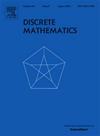三次图中的顶点很漂亮
IF 0.7
3区 数学
Q2 MATHEMATICS
引用次数: 0
摘要
如果G−V(G ‘)具有完美匹配,则图G的子图G ’是好的。好的子图在匹配覆盖图的子图分解和子图匹配理论中起着至关重要的作用。如果一个三次图的顶点u和它的邻点能生成一个很好的子图,那么它就是一个很好的顶点u。D. Král等人(2010)[9]表明立方体砖的每个顶点都很好。问一个匹配的有盖三次图有多少顶点是很自然的。本文利用匹配覆盖图的一些基本结果,证明了如果非二部三次图G是2连通的,则G至少有4个好点;如果G是3连通的并且G≠K4,那么G至少有6个顶点。我们还确定了所有相应的极值图。对于具有二分(a,B)的三次二部图G,如果顶点a∈a和B∈B与它们的相邻顶点a和B产生一个好的子图,则称顶点a∈a和B∈B是一个好的对。我们证明了连通三次二部图G是一个括号当且仅当不同颜色类中的每对顶点都是一个漂亮的对。一般来说,我们证明了G至少有9对顶点K3是唯一的极值图。本文章由计算机程序翻译,如有差异,请以英文原文为准。
Nice vertices in cubic graphs
A subgraph of a graph G is nice if has a perfect matching. Nice subgraphs play a vital role in the theory of ear decomposition and matching minors of matching covered graphs. A vertex u of a cubic graph is nice if u and its neighbors induce a nice subgraph. D. Král et al. (2010) [9] showed that each vertex of a cubic brick is nice. It is natural to ask how many nice vertices a matching covered cubic graph has. In this paper, using some basic results of matching covered graphs, we prove that if a non-bipartite cubic graph G is 2-connected, then G has at least 4 nice vertices; if G is 3-connected and , then G has at least 6 nice vertices. We also determine all the corresponding extremal graphs. For a cubic bipartite graph G with bipartition , a pair of vertices and is called a nice pair if a and b together with their neighbors induce a nice subgraph. We show that a connected cubic bipartite graph G is a brace if and only if each pair of vertices in distinct color classes is a nice pair. In general, we prove that G has at least 9 nice pairs of vertices and is the only extremal graph.
求助全文
通过发布文献求助,成功后即可免费获取论文全文。
去求助
来源期刊

Discrete Mathematics
数学-数学
CiteScore
1.50
自引率
12.50%
发文量
424
审稿时长
6 months
期刊介绍:
Discrete Mathematics provides a common forum for significant research in many areas of discrete mathematics and combinatorics. Among the fields covered by Discrete Mathematics are graph and hypergraph theory, enumeration, coding theory, block designs, the combinatorics of partially ordered sets, extremal set theory, matroid theory, algebraic combinatorics, discrete geometry, matrices, and discrete probability theory.
Items in the journal include research articles (Contributions or Notes, depending on length) and survey/expository articles (Perspectives). Efforts are made to process the submission of Notes (short articles) quickly. The Perspectives section features expository articles accessible to a broad audience that cast new light or present unifying points of view on well-known or insufficiently-known topics.
 求助内容:
求助内容: 应助结果提醒方式:
应助结果提醒方式:


